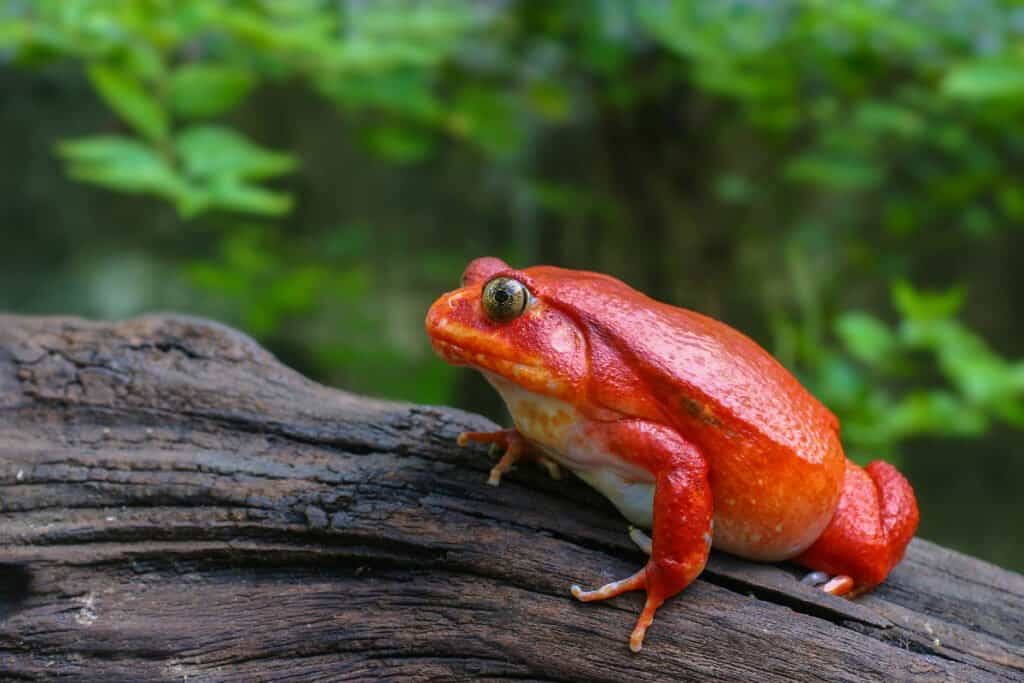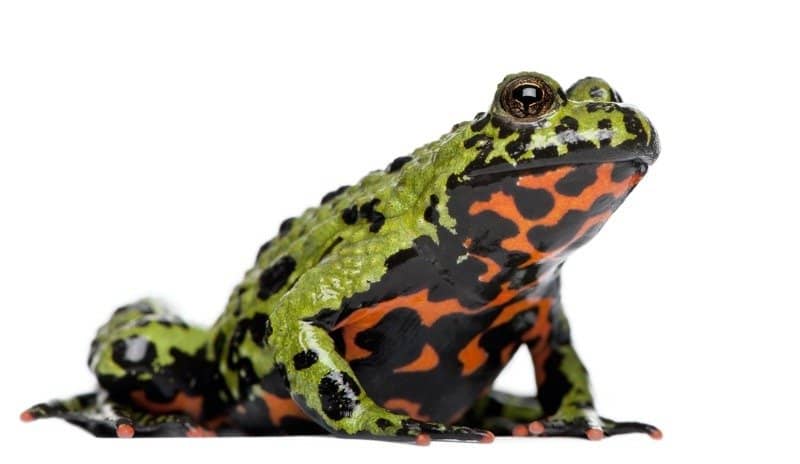While no exotic pets are truly “cheap” in the long run, it can still be worth considering less expensive, more manageable options, particularly if you’re a beginner to owning them. There are actually many great contenders when it comes to pet frogs, and below, we’ll explore five of your best, cheapest options as far as their initial cost, setup, and long-term expenses.
5. White’s Tree Frog/Australian Green Tree Frog (Litoria caerulea)

These healthy, hardy, amiable frogs are fairly inexpensive as pets.
©Hwe Ie/Shutterstock.com
Despite being the most expensive on this list in terms of initial cost, these hardy, gregarious frogs make excellent pets if you’re perhaps new to owning frogs and/or are looking to cut costs. Australian green tree frogs go by a few different common names, but they belong to the species Litoria caerulea taxonomically.
These large, bright green amphibians are native to Australia and New Guinea. However, they’ve been introduced to a few other regions worldwide as well. They’re the most expensive frogs on this list in terms of initial cost at around $30 to $40 per frog, which is still a fairly low price compared to many other pet amphibians.
White’s tree frogs reach around 4 inches long and are quite rotund, making them the largest frogs on this list, too. This also means they need fairly spacious enclosures, which you’ll also need to factor into your budget. Notably, they have fairly long lifespans of up to 15 years, so keep this in mind when making your decision. Overall, though, they’re very healthy and on the lower end maintenance-wise, meaning they’re pretty cheap long-term as far as frogs go.
4. Banded Bullfrog/Chubby Frog (Kaloula pulchra)

Banded bullfrogs are native to Southeast Asia.
©CoreRock/Shutterstock.com
Up next we have the banded bullfrog, better known simply as the chubby frog for its adorably round, pudgy appearance. These little brown frogs are native to southeast Asia, and they’re part of the Microhylidae family taxonomically, meaning they have narrow mouths for their size. The “banded” part of their alternative common name comes from the light brown stripes running down each side of their dark brown bodies from nose to rump.
These frogs are small yet hardy at around 2 to 3 inches long. However, they’re fairly hardy despite their diminutive size. While they aren’t quite as long-lived as some of the other species on this list, they can live for around 10 years with proper care. Furthermore, although they are fairly docile and mild-mannered overall, they don’t tolerate excessive handling terribly well. They can actually secrete a slimy, slightly toxic substance from their skin and inflate their bodies to a larger size if they feel threatened.
The initial cost for a single-banded bullfrog will run you around $20, making them a pretty cheap pet frog. They also can live comfortably in rather small, 15-to-20-gallon enclosures and don’t need very elaborate setups to thrive. This, of course, helps minimize long-term costs and maintenance, so they’re a great, inexpensive option for beginners and herpetology experts alike.
3. Tomato Frog (Dyscophus genus; 3 species)

Tomato frogs get their common name from their vibrant red color.
©Krisda Ponchaipulltawee/Shutterstock.com
The next cheapest pet frog on our list is the handsomely colorful tomato frog. There are actually three species of tomato frogs that all fall under the Dyscophus genus. These frogs all are native to Madagascar, are similar in size, and mostly vary only in color, which ranges from pale orange to bright, tomato red.
Like the banded bullfrog, tomato frogs can also secrete a toxin from their skin when threatened, though this substance is usually only mildly irritating to the skin. In some humans, however, it can cause a mild allergic reaction, so you will want to handle them with care.
Tomato frogs make great pets due to their small size, attractive appearance, and low-maintenance care requirements long-term. They can live for anywhere from 6 to 10 years, occasionally slightly longer if given optimal care. They are ambush predators that mainly feed on small insects and invertebrates.
The initial cost of a single tomato frog will run you around $15 to $20. Furthermore, it is possible to comfortably house them in fairly small, 20-gallon enclosures. This all means they are fairly cheap pet frogs and can be ideal pets for exotic pet keepers of all experience levels.
2. Fire-Bellied Toad (Bombina genus; 6 species)

True to its name, the fire-bellied toad has a bright orange-to-red abdomen.
©Eric Isselee/Shutterstock.com
The fire-bellied toad might not seem like an ideal option for this list at first, as we’re mainly talking about frogs here. However, it’s worth noting that all toads are technically frogs that all belong to the Anura order taxonomically. This, of course, includes the vibrant fire-bellied toad. These tiny toads are native to parts of Europe and Asia and are the smallest option on this list, measuring a mere 1.5 inches or so in length.
Fire-bellied toads get their common name from their bright, reddish abdomens, which they use as a form of aposematic or threat coloration to warn predators of their rather unappetizing taste. They can even arch their backs to expose their bellies to predators in a display known as unkenreflex. Despite all this posturing in the wild, however, in captivity, the frogs are generally pretty mild-mannered and easy to care for.
The initial cost for a single fire-bellied toad is only around $5 to $10. But keep in mind these frogs do very well in groups, and it’s a good idea to house at least two of them together. They can thrive in small, semi-aquatic enclosures of around 20 gallons in size. Overall, they’re pretty low-maintenance, healthy, and hardy frogs that are among the cheapest you can get.
1. Pac-Man Frog/South American Horned Frog (Ceratophrys genus; 8 species)

Pac-man frogs are low-maintenance and fairly inexpensive pets.
©Valt Ahyppo/Shutterstock.com
While all of the frogs listed here are pretty cheap as far as their initial and long-term costs go, the popular Pac-man frog might be the best option for most exotic pet owners. There are actually eight total species of Pac-man frogs, sometimes also known as South American horned frogs, for their native habitat and the small horn-like protrusions above their eyes. The eight species mainly differ only slightly by appearance and their country of origin.
These frogs range from around 3 to 5 inches and can be quite pudgy due to their ravenous eating habits. They feed mainly on insects and should be kept in solitary enclosures, as they are highly opportunistic and even cannibalistic in some cases. They tolerate handling quite well for a frog, and they can thrive in very small, 10-gallon enclosures due to their sedentary lifestyles.
The initial cost of a single Pac-man frog is slightly higher than a few of the aforementioned options listed here at around $15 to $20. However, their long-term care requirements are very manageable and their enclosure size requirements are small, making them very cost-effective pets in the long run!
The photo featured at the top of this post is © Krisda Ponchaipulltawee/Shutterstock.com
Thank you for reading! Have some feedback for us? Contact the AZ Animals editorial team.






